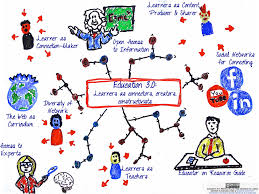I did a lot of research in preparation for our presentation last week, and I was only able to skim the surface in my allotted time, so I chose this as my platform to talk more about this thing called Web 3.0.
Trying to explain Web 3.0 is not an easy task. Web 3.0 is “under construction” so to speak, and as such I found it quite difficult to wrap my head around this emerging concept.
What is Web 3.0?
Overall, it very hard to define and explain, but I will make these points:
- Evolution/Extension of the current Web 2.0 OR
- An entity all it’s own; based on connective intelligence
- The idea that it is possible to edit information in such way that machines process it and link data.
- Often called “The Semantic Web” (Wikipedia)
- The semantic web might be described as an effort to make the internet more automatic and “smarter” in the way it interacts with humans
- Semantic web is about bringing customized information to the user, rather than having the user have to go out and find it
The Internet of Things
More and more physical objects are linked with IP addresses. This is the idea of the Internet of Things (IoT).
- everyday objects are connected to the Internet, allowing them to send and receive data.
The video shown below (although from the European perspective) gives us a glimpse into what our future might look like.
How does Web 3.0 work?
- Content generated by community: we see the start of this with web 2.0 and things like Facebook and Wikis, but this is more. As more people and devices become connected, opportunities to generate content are endless. So what do we do with that content??
- “Teaching” computers how to make meaning out of data
- We will have to “teach” computers meaning, so relationships and connections can be made (the programming of this is touched on in the TED talk we included, but in addition to words, computers have to programmed to understand grammar and logic and relationships as well).
- Interchange of data vs interchange of documents
- Based on metadata → contains details concerning the relationships between pieces of information
- Intelligent linking of data→ arranging information, classifying, interpreting
Examples of Web 3.0
- Bing Reference Search: I am not a fan of Bing, but apparently the reference search “shows the natural language capabilities of their semantic technology.”
- Twine: open-source tool for telling interactive stories, looks like it can also be used to create games, you can post anywhere, use it how and when you want, operated by different people in different locations.
- Google Squared: Dead, 2009 Google project→ first significant effort by Google to understand information on the web, information was presented in a spreadsheet
- Google Physical Web Project, “everything is a tap away” The Physical Web enables you to see a list of URLs being broadcast by objects in the environment around you. Any object can be embedded with a Bluetooth Low Energy (BLE) beacon, which is a low powered, battery efficient device that broadcasts content over bluetooth. Crazy!
- Nest Thermostat – “learns what you like”
- Fitbit
- Apple Watch
What will be made possible for teachers?
Education 3.0
- Faster and more efficient access to info
- Search engines able to search for the actual individual user’s interests
- Extends the network
- Collaboration, connection, personalization
Challenges
- Difficulty of incorporating into existing web→ there’s already a lot out there, plus it involves additional work
- Honesty of people → authors have to provide correct meaningful keywords; using tags to improve search engine rankings
- Describing relationships→ not always easy
- Censorship → the more that is out there, the more there is to censor.
- Increased privacy and security risks→ it’s easier than ever find out other people’s likes, dislikes, hobbies (advertisements)
- Web accessibility, Digital Divide→ as the Semantic Web and IoT develops, the gap between those who are connected and those that aren’t widens.
- Readiness of the users → are we truly ready for such a seismic shift?
So, what do you think? Are you ready for Web 3.0?

